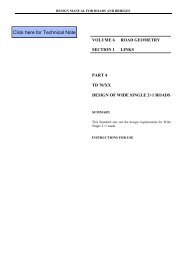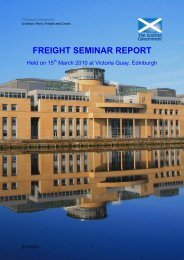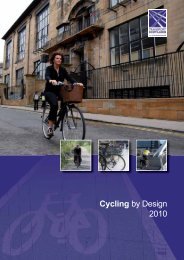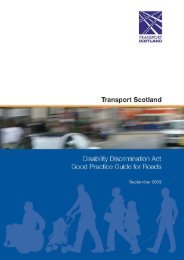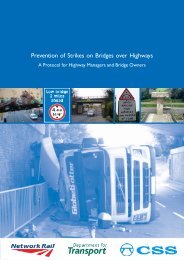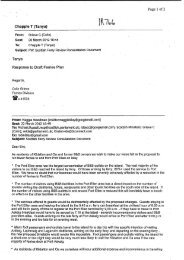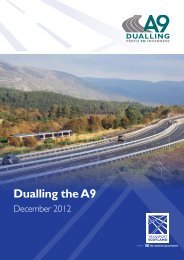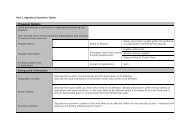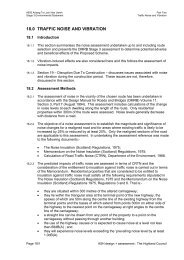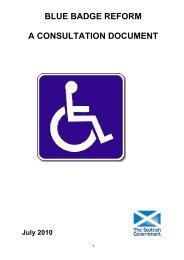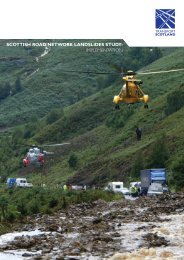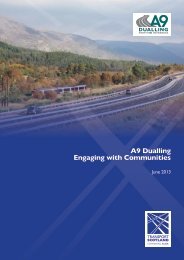Public Transport Model Calibration and Validation Report
Public Transport Model Calibration and Validation Report
Public Transport Model Calibration and Validation Report
You also want an ePaper? Increase the reach of your titles
YUMPU automatically turns print PDFs into web optimized ePapers that Google loves.
4 Conclusions <strong>and</strong> Recommendations<br />
4.1 Summary<br />
4.1.1 This report has presented the calibration <strong>and</strong> validation of the TMfS:07 National <strong>Public</strong><br />
<strong>Transport</strong> <strong>Model</strong>.<br />
4.1.2 There are several enhancements to the TMfS:07 National <strong>Public</strong> <strong>Transport</strong> <strong>Model</strong> over <strong>and</strong><br />
above that of the previous versions, including:<br />
• transition of modelling software to CUBE Voyager;<br />
• the modelled transport network has been developed in GIS to give better<br />
representation of actual road network (geo-rectification);<br />
• the inclusion of a range of data including; National Rail Travel Survey (NRTS), Inter-<br />
Urban Bus Survey <strong>and</strong> Census Journey to Work data in the dem<strong>and</strong> matrices. This<br />
forms a significant improvement in the representation of travel dem<strong>and</strong> compared to<br />
previous model versions;<br />
• use of independent comprehensive ScotRail count data for validation; <strong>and</strong><br />
• dem<strong>and</strong> matrices disaggregated by user class with multi-class assignment.<br />
4.2 <strong>Validation</strong><br />
4.2.1 Throughout the validation, it is important to note that the travel dem<strong>and</strong> matrix information<br />
is independent of the validation count information. Due to the high quality of the underlying<br />
travel dem<strong>and</strong> information (from NRTS <strong>and</strong> the Census), there is no specific procedure<br />
undertaken to re-estimate the travel dem<strong>and</strong> matrices to specifically match the independent<br />
counts. Therefore, there is a greater degree of scope for the counts versus modelled flows<br />
to differ.<br />
4.2.2 For passenger loading, validation has been carried out to observed passenger counts <strong>and</strong> the<br />
results have generally been satisfactory. The city centre cordons are generally within an<br />
acceptable range, though there is some local variation. Overall the individual site count<br />
comparisons are also within an acceptable range, however, there are some sites that are less<br />
well validated.<br />
4.2.3 Boarding <strong>and</strong> alighting comparisons also indicate a reasonable level correlation at the global<br />
level, however, there is a greater degree of variability at the individual station level.<br />
4.2.4 <strong>Model</strong>led bus journey times are generally quicker than the timetabled journey times, but this<br />
can be typical of PT models because of their strategic nature. Overall there is generally a<br />
reasonable match between modelled <strong>and</strong> timetabled bus journey times.<br />
4.2.5 Overall the level of validation is considered within an appropriate range <strong>and</strong> is similar to the<br />
previous release version of TMfS (TMfS:05A). However, there is a higher degree of<br />
confidence in the underlying data that has been used to develop <strong>and</strong> validate the TMfS:07<br />
model.<br />
TMfS:07 National <strong>Public</strong> <strong>Transport</strong> <strong>Model</strong> <strong>Calibration</strong> <strong>and</strong> <strong>Validation</strong> <strong>Report</strong> 4.1



